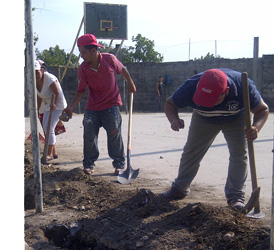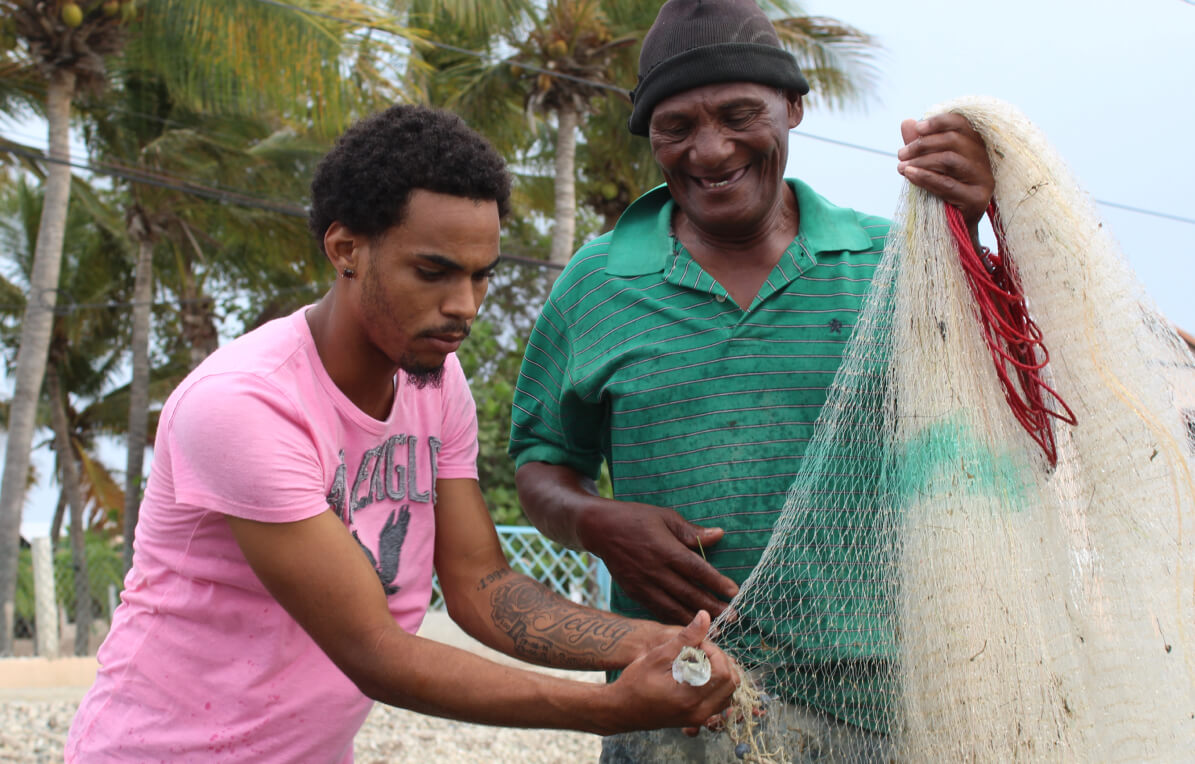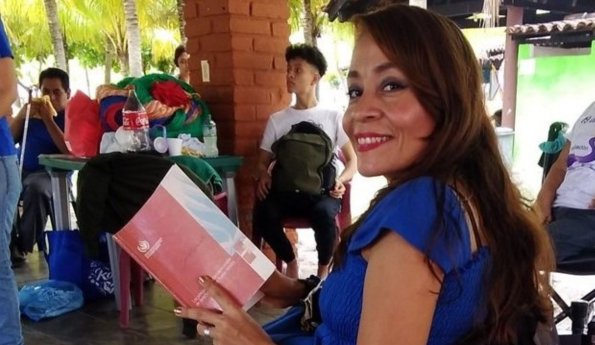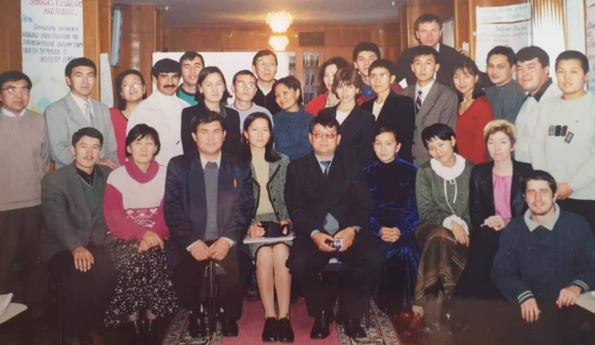By Jennifer Brookland
It was a disaster that gave the community where Doris Janet Alberto grew up its name.
In 1974, before Doris was born, Hurricane Fifi just skimmed the northern coast of Honduras before weakening into a tropical depression. It was enough to dump two feet of rain and cause mudslides and flash floods that destroyed 182 towns in a single day. More than 2,000 people in the town of Choloma were killed.
Residents today in Doris’s Choloma neighborhood were so grateful when international aid organization CARE rebuilt 50 homes among the ruined storefronts and fields that they’ve called the neighborhood Care ever since.
Care is where Doris grew up and went to school, where she worked and married and now lives atop a steep hill overlooking a tree perfectly limbed for fearless children to climb.
But over the years, Doris watched as other, manmade disasters struck her neighborhood. Violence and poverty battered Honduras, fed by endemic corruption as warm ocean water fuels a storm.
With two rival gangs in Care, “it was like death stalking you from behind,” says Doris.
From the capital of Tegucigalpa to little neighborhoods like Care, sixty-five percent of Hondurans fell below the poverty line, nearly a quarter became malnourished and gangs turned neighborhood businesses into personal piggy banks.
“Here you work and your work comes to nothing,” Doris’s husband said as he followed his brothers’ examples and fled the country, leaving her behind with two young children and one year-old twins.
The twins are eight years old now, and Doris heard that her husband married someone else. Hers is one of many families eroded by the caustic combination of underdevelopment, insecurity and graft.
“We’re losing our social capital,” says Gloria Manzanares, Counterpart International’s country director in Honduras. “It’s in all different sectors and all different classes, from the rural area peasants to the urban areas. We’re losing our population, and it’s very unfortunate.”
Coming Together to Make a Change
Doris and many of her neighbors are not willing to keep watching idly as families splinter, children swap pencils for pistols and communities remain mired in poverty.
Across Honduras, Counterpart is working hand in hand with civil society organizations (CSOs) to empower communities like Care to take control of the problems that have plagued them for decades.
Its Community Action for Prosperity (CAP) project distributed institutional support and civic participation grants to nine CSOs that work on issues like human rights, youth employment and violence prevention.
Increased technical support, monitoring, and project management skills allow these CSOs to improve their capacity and communication: they gain presentation skills, tactics for collaborating with local authorities and advice on engaging young people.
“The support has been very important—from the standpoint of operating strategies, monitoring and evaluation, outlining and planning processes, and general approach,” says Adelina Vasquez, Executive Director of the Center for Human Development, one of the nine partner organizations.
The work sounds nebulous, even esoteric. But these organizations partner with local residents on tangible projects that are identified, prioritized and carried out by community development committees (CDCs). And they aren’t afraid of getting their hands dirty.
In Care, a basketball court is taking form as men and women stoop to clear rocks and dig a surrounding ditch. Children help out by moving smaller stones, throwing a few at less favored peers. Alberto’s mom is there rake in hand, in a red flowered skirt and pink baseball cap.
When the CAPproject started in Care, it worked through local development organization Fundacion Nacional para el Desarrollo de Honduras (FUNADEH) to establish community groups that would be respected and representative.
“First they trained us to develop our capabilities to form the committee and to be sure what we wanted and what we could do,” says Doris. “After that, I felt prepared, satisfied, proud, and above all confident that we can go to the community to address a situation with a project—something—and understand, and above all believe.”
People in Care formed a community revitalization committee, started holding workshops for young people on leadership and brainstormed projects that would make life just a little better.
With nowhere safe and productive for kids and teens to hang out, they decided on the basketball court and park, and mobilized men, women and children to pitch in.
“We just started these projects but people are getting very involved,” says Mario Enrique Torres, a local leader in a holey white t-shirt who offers up his home for community meetings. “We feel motivated. Yesterday, fewer came than today.”
Maribel de Jesus Alcerro and her 18 year-old daughter Ingrid Magdarilanza are both members of Care’s CDC.
“I envision my community free of gangs, with young people more involved in education than drugs, gangs and kidnapping,” Ingrid says, taking a break from work on the new court. “These kinds of places give young people other opportunities.”
Ingrid had to drop out of school after eighth grade when the family could no longer afford the fees. She’d like to go back but, at her age, is not sure if she can. Getting personally involved in making positive changes is something she can do to avoid the traps she’s seen others fall into.
“This is a way for them to see positive things to do instead of all the other things,” Ingrid says.
Those “other things” include drugs, robberies and teen pregnancies. Now, Ingrid says, those kids have no access to jobs and few prospects.
Local leaders hope their efforts in Care will be noticed by neighboring communities too.
“It is important not just for us to participate, but for everyone to see that when they see [Care residents] coming together, why should they not do the same?” says Enrique.
Building More Than Structures
These projects are successful because of the real benefits they have produced for 160,000 people. Having a basketball court, a computer lab or vocational training creates connections and opportunities that people in these neighborhoods have craved for years.
But just as important is the way the program has motivated communities to come together, take ownership of their problems, and feel supported as they make changes for themselves.
Though nonprofits and donors often look for the results they can touch to show progress, the real gains are sometimes less tangible, says Judy Donaire, Senior Program Assistant with CAP.
“We sometimes look to the buildings, to all these projects that you can see easily,” says Donaire. “But more often the signs of success are changes in mentality, and a sense of solidarity, and the motivation to change their community.”
These signs are starting to appear, in the willingness of the people of Care to rake the rocks from the new basketball court they worked together to build, for instance.
“These are the most profound changes that we have seen. These people are willing to do activities not only for themselves, but for their neighbors,” says Donaire.
And feeling the support from local and international organizations is boosting everyone’s drive to keep going despite the difficulties. Manzanares is starting to see changes ripple across the communities that CAP works in.
“We are seeing that each day they are feeling more empowered,” she says. “Each day we see a difference.”
This energy is starting to pick up, to swirl around like a growing storm.
Gusts of motivation are pushing people to stand up for themselves and their neighbors, to stand up and make Honduras a place where families will want to stay, and where they can thrive.
This storm will sweep across the country, and communities will have themselves to thank.




